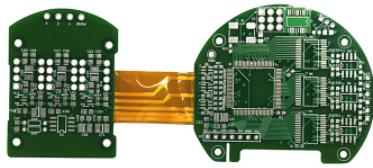1 Flexibility and reliability of flexible circuits
Four types of flexible circuits are currently prevailing: single-sided, double-sided, multilayer, and rigid-flex combination. Friedman said: "Single-sided flexible circuit boards have the lowest cost. When electrical performance is not high and single-sided wiring is available, single-sided flexible circuit boards should be used." This most common form has been commercialized, such as The inkjet cartridge of the printer and the memory of the computer. The single-sided flexible circuit board has a layer of chemically etched conductive patterns, and the conductive pattern layer on the surface of the flexible insulating substrate is a rolled copper foil. The insulating substrate used for flexible assembly can be polyimide (Kapton), polyethylene terephthalate (PET), aramid fiber paper (Nomex) and polyvinyl chloride (PVC).
The double-sided flexible circuit board is a conductive pattern made by etching on both sides of the base film. The metallized hole connects the patterns on both sides of the insulating material to form a conductive path to meet the design and use function of flexibility. The cover film can protect single and double-sided wires and indicate where the components are placed.
Multi-layer flexible circuit boards are made by laminating three or more layers of single-sided flexible circuits or double-sided flexible circuits together. Metallized holes are formed by drilling and electroplating to form conductive paths between different layers. In this way, there is no need to use a complicated welding process. Al Balzano, vice president and general manager of Basic Electronics in Garden Grove, California, said: "Multilayer circuits have huge functional differences in terms of higher reliability, better thermal conductivity, and easier assembly performance." Although the number of conductive layers designed for this flexible type can be unlimited, in order to ensure ease of assembly when designing the layout, the mutual influence of assembly size, number of layers and flexibility should be considered.

The traditional rigid-flex board is composed of rigid and flexible substrates selectively laminated together. The structure is compact, and the conductive connection is formed with metalized holes. Mario Amalfitano, International Sales Manager of Aero Flexible Ciruitry in Torrance, California, commented: "If your board has components on the front and back sides, rigid-flex board is a good choice. But if all the components are in For one side, it is more economical to choose a double-sided flexible circuit board and laminate a layer of FR-4 reinforced material on its back. FR-4 will not form electrical connections with metallized holes or effective flexible circuits, but Play a reinforcement role. This not only enhances the reliability, but also reduces the manufacturing process or the process of installing components, or the damage after the installation of the components." Amalfitano suggests that considering the reliability and price factors, the manufacturer should try to keep the number of layers as small as possible .
The flexible circuit industry is undergoing small but rapid development. The polymer thick film method (PTF) is an efficient and low-cost production process for circuit boards. The process is to selectively screen print conductive polymer inks on a cheap flexible substrate. Its representative flexible substrate is PET. PTF conductors include silk-screened metal fillers or carbon powder fillers. PTF itself is very clean, using lead-free SMT adhesive, no need to etch. Al Hollenbeck, Technical Director of Poly-Flex in RI Cranstom, said: "Because of its use of additive processes and low-cost substrates, PTF circuits are ten times cheaper than copper Kapton circuits and 2-3 times cheaper than PCBs. PTF is especially It is suitable for the control panel of equipment because of its low cost and easy assembly and replacement under the flat graphic panel. On mobile phones and other portable products, PTF is suitable for converting the components, switches and lighting devices on the PCB motherboard into PTF circuit. It not only saves cost, but also reduces energy consumption.
There is also a flexible circuit with a mixed structure, which is also a multilayer board, but the conductive layer of the multilayer board is composed of different metals. Jack Lexin, an application engineer at LEFlex Circuits in Carlsbad, California, said: "An 8-layer board uses FR-4 as the inner layer and kapton as the outer layer, extending from three different directions of the motherboard. Leads, each lead is made of a different metal. Constantan alloy, copper and gold are used as independent leads. "This kind of mixed structure is mostly used in the relationship between electrical signal conversion and heat conversion and the low temperature where the electrical performance is relatively harsh. in the case of. In this case, flexible hybrid circuits are the only feasible solution.
Whether the structure of these flexible circuits saves costs and is optimally utilized can be evaluated by the convenience of the interconnection design and the total cost. George Serpa is a contract manufacturer of Flextronics International in San Jose, Califonia. As a senior product R&D engineer, I have a good understanding of flexible assemblies. "The overall way of interconnection is different. Mobile phones are in block layout; laptops are in XY orientation; printers are in rigid-flex PCB format. These products are made of different materials with different prices to reduce The cost of connecting leads. Each design must be typologically evaluated to achieve the best performance-to-price ratio."